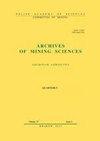煤矿巷道气流速度边界层的现场与试验研究
IF 1.2
4区 工程技术
Q3 MINING & MINERAL PROCESSING
引用次数: 3
摘要
井下空气流动时,隧道壁附近存在一个气流速度边界层。气流速度边界层的厚度和分布可能会影响通过该流动界面进入通风气流的有害和有毒气体的排放。它还可能对煤矿瓦斯爆炸产生重大影响。现场测量结果和模拟实验数据用于研究平壁矿井巷道中的气流速度边界层,该边界层依次被认为是:无支撑的工字钢分段拱或螺栓和喷丸形成支撑的横截面。通过参考其他考虑边界层特征的文献研究以及对现场和实验数据集的分析,我们获得了每个支护路段对应的气流速度边界层特征。假设边界层内的气流速度增加遵循由表达式给出的对数定律:u=aLn(x)+b。结果表明,气流速度边界层的厚度随气流中心速度的增加而显著减小,随巷道壁面粗糙度的增加而增加。对于考虑中心气流速度影响的三种类型的煤矿巷道,气流速度分布由方程u=(m1v+n1)Ln(d)+m2v+n2来描述。本文章由计算机程序翻译,如有差异,请以英文原文为准。
Field and Experimental Research on Airflow Velocity Boundary Layer in Coal Mine Roadway
There is an airflow velocity boundary layer near tunnel wall when the air is flowing in the undergro- und coal mine. The thickness and distribution of the airflow velocity boundary layer could influence the discharge of harmful and toxic gases that enter the ventilating airflow through this flow interface. It may also have a major impact in coal mine gas explosion. The results of field measurements and simulation experimental data are used to research airflow velocity boundary layer in a flat walled mine roadway, which is considered in turn: as unsupported, I-steel sectioned arch or bolted and shot create supported cross section. By referenced to other literature studies that consider boundary layer characteristics and the analysis of on-site and experimental data sets we obtain the corresponding airflow velocity boundary layer characteristics for each of the supported roadway sections. The airflow velocity within the boundary layer increase is assumed to follow a logarithmic law given by the expression: u = a Ln( x ) + b . It is concluded that the thickness of the airflow velocity boundary layer is observed to significantly decrease with the airflow center velocity and to increase with roadway wall roughness. The airflow velocity distribution is found to be described by the equation: u = ( m 1 v + n 1 )Ln( d ) + m 2 v + n 2 , for the three types coal mine tunnel taking into account the influence of center airflow velocity.
求助全文
通过发布文献求助,成功后即可免费获取论文全文。
去求助
来源期刊

Archives of Mining Sciences
工程技术-矿业与矿物加工
CiteScore
2.40
自引率
16.70%
发文量
0
审稿时长
20 months
期刊介绍:
Archives of Mining Sciences (AMS) is concerned with original research, new developments and case studies in mining sciences and energy, civil engineering and environmental engineering. The journal provides an international forum for the publication of high quality research results in:
mining technologies,
mineral processing,
stability of mine workings,
mining machine science,
ventilation systems,
rock mechanics,
termodynamics,
underground storage of oil and gas,
mining and engineering geology,
geotechnical engineering,
tunnelling,
design and construction of tunnels,
design and construction on mining areas,
mining geodesy,
environmental protection in mining,
revitalisation of postindustrial areas.
Papers are welcomed on all relevant topics and especially on theoretical developments, analytical methods, numerical methods, rock testing, site investigation, and case studies.
 求助内容:
求助内容: 应助结果提醒方式:
应助结果提醒方式:


